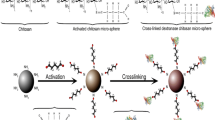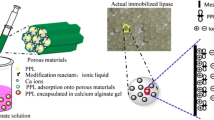Abstract
A novel immobilized enzyme system supported by poly(acrylic acid/N,N’-methylene-bisacryl-amide) hydrogel microspheres was prepared. This system exhibited characteristics of reversible pH-triggered release. The morphology, size, and chemical structure were examined through optical microscopy, particle size analyzer, and Fourier transform infrared spectrometer. Immobilization and release features were further investigated under different conditions, including pH, time, and microsphere quantity. Results showed the microspheres were regularly spherical with 3.8 ~ 6.6 μm diameter. Loading efficiencies of bovine serum albumin immobilized by gel entrapment and adsorption methods were 93.9% and 56.2%, respectively. The pH-triggered protein release of the system occurred when medium pH was above 6.0, while it was hardly detected when medium pH was below 6.0. Release efficiencies of entrapped and adsorbed protein were 6.38% and 95.0%, respectively. Hence, adsorption method was used to immobilize trypsin. Loading efficiency of 77.2% was achieved at pH 4.0 in 1 h. Release efficiency of 91.6% was obtained under optimum pH catalysis condition set at 8.0 and trypsin was free in solutions with retention activity of 63.3%. And 51.5% of released trypsin could be reloaded in 10 min. The results indicate this kind of immobilized enzyme system offers a promising alternative for enzyme recovery in biotechnology.






Similar content being viewed by others
Abbreviations
- AAc:
-
acrylic acid
- MBA:
-
N,N′-methylene-bisacrylamide
- BSA:
-
bovine serum albumin
- TEMED:
-
N,N,N′,N′-tetramethylethylenediamine
- BAEE:
-
N-Benzoyl-L-arginine ethylester hydrochloride
- p(AAc/MBA):
-
poly(acrylic acid/N,N′-methylene-bisacryl-amide)
- D pH :
-
main particle size of p(AAc/MBA) microspheres at certain pH
- ηL :
-
loading efficiency
- ηR :
-
release efficiency
- ηU :
-
recovery efficiency
- Ci :
-
initial BSA concentration introduced
- Cf :
-
final BSA concentration in supernatants after immobilization
- Cr :
-
BSA concentration in supernatants after release
- Cu :
-
BSA concentration in supernatants after recovery
- Vl :
-
loading solution volume
- Vr :
-
release solution volume
References
Jahnz, U., Schubert, M., Baars-Hibbe, H., & Vorlop, K. D. (2003). International Journal of Pharmaceutics, 256, 199–206. doi:10.1016/S0378-5173(03)00078-4.
Guilbault, G. G. (1982). Applied Biochemistry and Biotechnology, 7, 85–98. doi:10.1007/BF02798629.
Brahim, S., Narinesingh, D., & Guiseppi-Elie, A. (2002). Biosensors & Bioelectronics, 17, 973–981. doi:10.1016/S0956-5663(02)00089-1.
KatzirKatchalski, E. (1980). Enzyme engineering. New York, NY: Plenum Press.
Nenelson, D., & Maria, A. (2002). Enzyme and Microbial Technology, 31, 907–931. doi:10.1016/S0141-0229(02)00214-4.
Piacquadio, P., & Stefano, G. D. (1997). Biotechnology Techniques, 11, 515–517. doi:10.1023/A:1018418201268.
Krajewska, B. (2004). Enzyme and Microbial Technology, 35, 126–139. doi:10.1016/j.enzmictec.2003.12.013.
Huckel, M., Wirth, H. J., & Hearn, M. T. W. (1996). Journal of Biochemical and Biophysical Methods, 31, 165–179. doi:10.1016/0165-022X(95)00035-P.
Bailey, J. E., & Cho, Y. K. (1983). Biotechnology and Bioengineering, 25, 1923–1935. doi:10.1002/bit.260250803.
Akala, E. O., Kopeckova, P., & Kopecek, J. (1998). Biomaterials, 19, 1037–1047. doi:10.1016/S0142-9612(98)00023-4.
Hiroki, A., Maekawa, Y., Yashioda, M., & Katakai, R. (2001). Polymer, 42, 6403–6408. doi:10.1016/S0032-3861(01)00112-4.
Okahata, Y., & Lim, H. J. (1984). Journal of the American Chemical Society, 106, 4696–4700. doi:10.1021/ja00329a010.
Desponds, A., & Freitag, R. (2005). Biotechnology and Bioengineering, 91, 583–591. doi:10.1002/bit.20479.
Galaev, I. Y., & Mattiasson, B. (1999). Trends in Biotechnology, 17, 335–340. doi:10.1016/S0167-7799(99)01345-1.
Brahim, S., Narinesingh, D., & Guiseppi-Elie, A. (2002). Journal of Molecular Catalysis. B, Enzymatic, 18, 69–80. doi:10.1016/S1381-1177(02)00061-9.
Bahar, T., & Tuncel, A. (2000). Reactive & Functional Polymers, 44, 71–78. doi:10.1016/S1381-5148(99)00081-4.
Arslan, F., Tümtürk, H., Çaykara, T., Sen, M., & Güven, O. (2000). Food Chemistry, 70, 33–38. doi:10.1016/S0956-7135(99)00114-0.
Kang, E. T., Tan, K. L., Kato, K., Uyama, Y., & Ikada, Y. (1996). Macromolecules, 29, 6872–6879. doi:10.1021/ma960161g.
Migneault, I., Dartiguenave, C., Bertrand, M. J., Vinh, J., & Waldron, K. C. (2004). Electrophoresis, 25, 1367–1378. doi:10.1002/elps.200305861.
Bryjak, J., Liesiene, J., & Kolarz, B. N. (2008). Colloids and Surfaces B, Biointerfaces, 61, 66–74. doi:10.1016/j.colsurfb.2007.07.006.
Alvarez-Lorenzo, C., & Concheiro, A. (2002). Journal of Controlled Release, 80, 247–257. doi:10.1016/S0168-3659(02)00032-9.
Bradford, M. M. (1976). Analytical Biochemistry, 72, 248–254. doi:10.1016/0003-2697(76)90527-3.
Rick, W. (1976). In H. U. Bergmeyer (Ed.), Methods of enzymatic analysis, vol. 2: Trypsin pp. 1013–1024. New York, NY: Academic Press.
Hu, J., Li, S., & Liu, B. (2006). Biotechnology Journal, 1, 75–79. doi:10.1002/biot.200500022.
Gil, E. S., & Hudson, S. M. (2004). Progress in Polymer Science, 29, 1173–1222. doi:10.1016/j.progpolymsci.2004.08.003.
Schwarte, L. M., Podual, K., & Peppas, N. A. (1998). Tailored polymeric materials for controlled delivery systems. Washington, DC: American Chemical Society.
Brahim, S., Narinesingh, D., & Guiseppi-Elie, A. (2003). Biomacromolecules, 4, 497–503. doi:10.1021/bm020080u.
Brahim, S., Narinesingh, D., & Guiseppi-Elie, A. (2003). Biomacromolecules, 4, 1224–1231. doi:10.1021/bm034048r.
Malmsten, M., & Larsson, A. (2000). Colloids and Surfaces. B, Biointerfaces, 18, 277–284. doi:10.1016/S0927-7765(99)00153-8.
Wu, S., Liu, B., & Li, S. (2005). International Journal of Biological Macromolecules, 37, 263–267. doi:10.1016/j.ijbiomac.2005.12.007.
Hamerska-Dudra, A., Bryjak, J., & Trochimczuk, A. W. (2007). Enzyme and Microbial Technology, 41, 197–204. doi:10.1016/j.enzmictec.2007.01.008.
Gacesa, P., & Hubble, J. (1987). Enzyme technology. Oxford, UK: Open University Press.
Acknowledgment
This study was supported by grants from the National Natural Science Foundations of China (Nos. 30772658 and 30570494).
Author information
Authors and Affiliations
Corresponding author
Rights and permissions
About this article
Cite this article
Gai, L., Wu, D. A Novel Reversible pH-Triggered Release Immobilized Enzyme System. Appl Biochem Biotechnol 158, 747–760 (2009). https://doi.org/10.1007/s12010-008-8373-2
Received:
Accepted:
Published:
Issue Date:
DOI: https://doi.org/10.1007/s12010-008-8373-2




